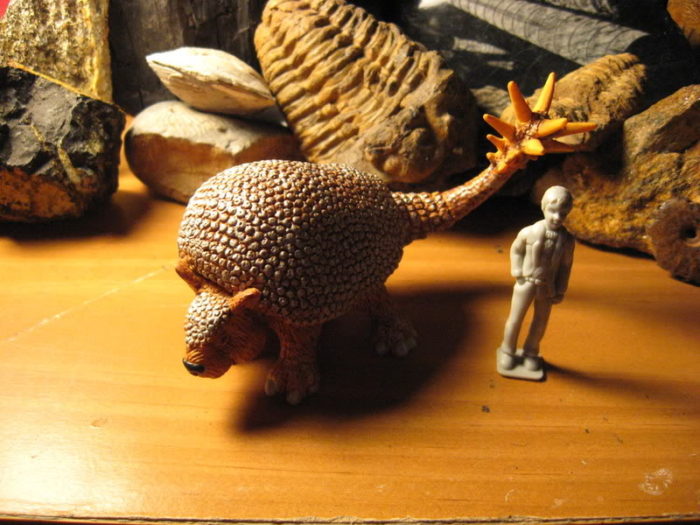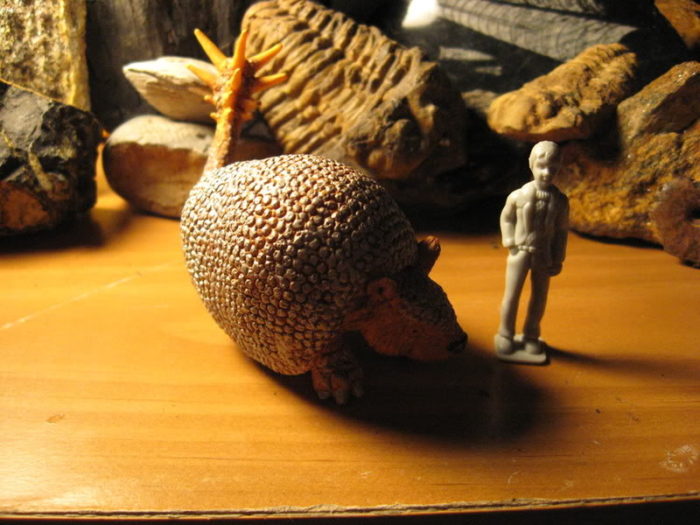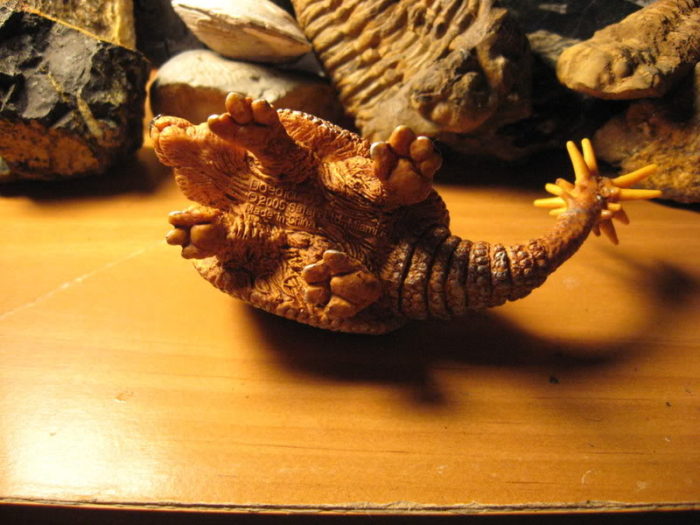Doedicurus was a large genus of glyptodont sporting a bony carapace and a tail ending in a spiked club. These adaptations may have been for defense from Smilodon, which coexisted with Doedicurus, but the club may also have been used during confrontations with other Doedicurus. These animals could reach 12 feet in length and weigh as much as a Volkswagen Beetle. Doedicurus fossils have been discovered in North and South America where it flourished during the Pleistocene, becoming extinct at the end of the Pleistocene Glaciation roughly 10,000 years ago. It is one of the more well known Pleistocene megafauna and it is possible that early paleoindians utilized the animal as a source of food, though no evidence for this has been found.

It is always nice to see a new genus introduced in replica form. I think it’s great that Safari chose to give us a new animal when they could have easily gotten away with dropping the tried and true Glyptodon on us. The figure is 4 inches long and is in roughly 1:40 scale, which I think is a big bonus with a figure. The armor is painted with a metallic silver color, as are the claws. Some of this color is splashed on each foot as well, but I’m not sure if it is intentional or just sloppy painting. The fur is a rusty brown, and this color also shows between the individual scutes on the carapace. The spikes on the club are dark yellow. The bottoms of the feet have a cool fleshy look. The animal is posed in such a way that it appears to be swinging that massive club. The figure is leaning to the right, putting its full weight behind the swing. I think this was a brilliant way for Safari to give what would otherwise have been a boring figure a touch of life.

As far as glyptodonts go this figure is superb. Safari could have modeled it based off of Glyptodon and been fine, but they appear to have done a little research. The hump at the front of the carapace is characteristic of Doedicurus as opposed to Glyptodon (which had an egg-shaped carapace) and is faithfully reproduced here. The tail club and spikes are also not present in Glyptodon, and end up making for a more exciting figure, which is why I think Safari chose to produce Doedicurus instead. The head is typical of the glytodontidae with its boxy shape and large cheeks, as well as a patch of armor on the cranium. The ears may be a bit big but they’re passable.

All in all, this figure is a very faithful reproduction of a prehistoric mammal which is quite well known from the fossil record. If you like expanding the genera in your collection or are a mammal enthusiast, this is for you.
Available from Amazon.com here.
Join the dino-discussions at the Dinosaur Toy Forum!
Support the Dinosaur Toy Blog by making dino-purchases through these links to Ebay and Amazon. Disclaimer: links to Ebay.com and Amazon.com on the The Dinosaur Toy Blog are often affiliate links, when you make purchases through these links we may make a commission

[…] This year the Dinosaur Toy Blog was delighted to be invited to participate in Safari Ltd’s #GimmeNewSafari launch campaign surrounding these new releases. This saw Safari Ltd select several ‘influencers’ to receive a sneak peek of their new products, so we’ve been waiting for our surprise to arrive to give it the old walk-around photography and review treatment. Unfortunately, the ‘new’ figure we received isn’t technically new, but rather a re-issue of a 2005 figure already reviewed on the Dinosaur Toy Blog in 2009. So, we don’t have anything exclusive to offer our readers after all, but it was nice of Safari Ltd to think of us. Check out our review of the Doedicurus (Prehistoric Life by Safari Ltd) here. […]
Pena de que sea tan pequeño. Si fuera del tamaño del Glyptodon de Schleich hubiese sido un animal mas vistoso. A mí aunque me gusta las exactitud y proporciones de los animales prehistóricos, me apasiona en este caso que se hiciese a una escala más grande este extraño animal, pena que lo hayan retirado
[…] The final animal in the tube is the glyptodont Doedicurus. The unmistakable spiked tail is accurately rendered. The figure has a cheeky face and the tail is striking out wildly. The rough bobbly texture of the armour is picked out with grey highlights. Once again, the pose of this tiny figure is almost identical to the larger Prehistoric Life Collection version (Reviewed here). […]